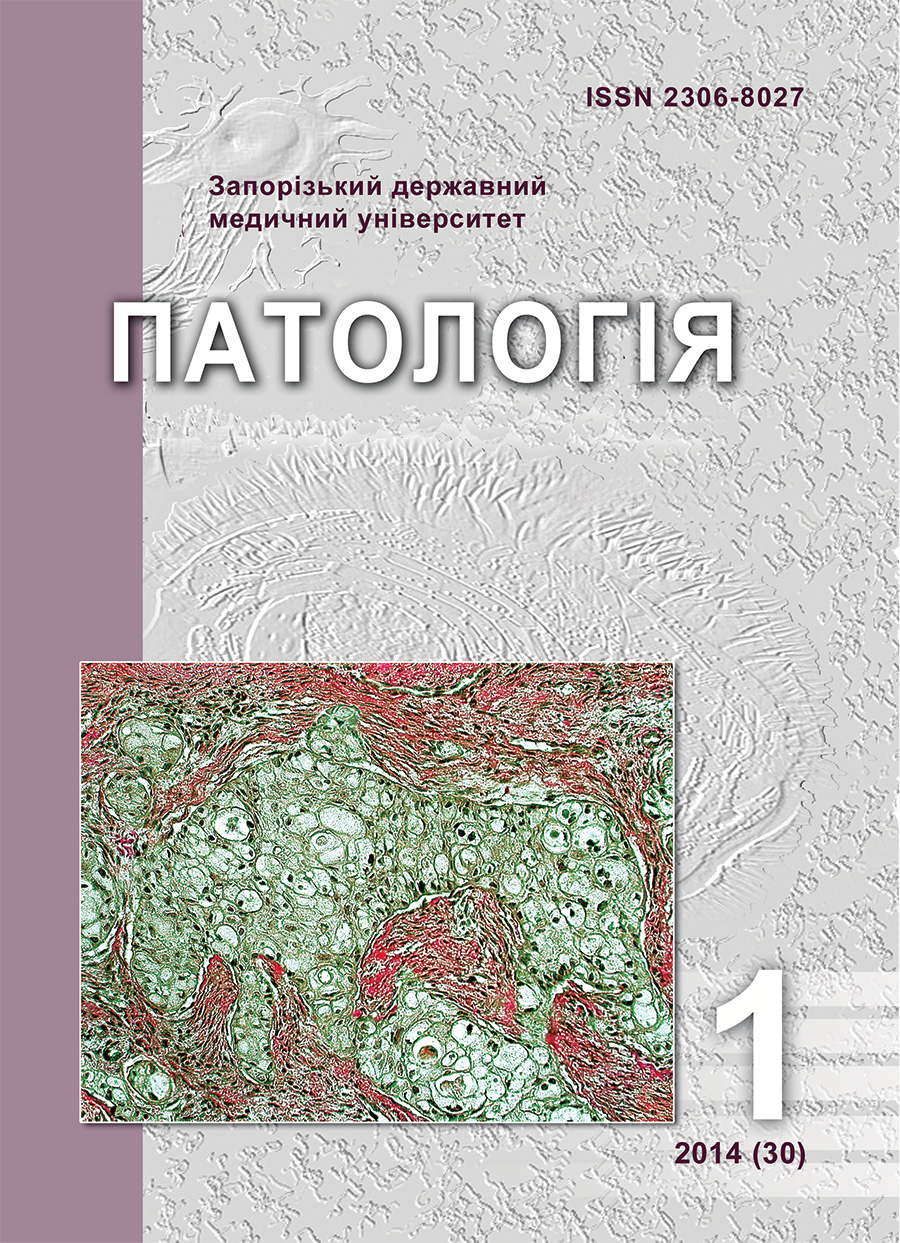Features of myocardial deformation in patients with ischemic heart disease with moderate dilatation of cavity of the left ventricle complicated by the myocardial infarction
DOI:
https://doi.org/10.14739/2310-1237.2014.1.25250Keywords:
myocardial ischemia, left ventricle, ultrasonographyAbstract
Aims. To explore the features of the myocardial deformation in patients with IHD.
Research objective: to study features of function of myocardium of the left ventricle in patients with IHD with the moderate dilatation of the left ventricle complicated by the myocardial infarction.
Methods and results.135 patients were included into the study. 60 of them had IHD with moderate left ventricle dilatation not complicated by myocardial infarction. 40 patients had IHD with myocardial infarction in anamnesis, 35 were healthy (comparison group). Left ventricle images were analyzed in concordance with 18-segmental model in grey scale as well as in the MSI and TDI regimen.
Primary levels of the myocardial deformation in patients with myocardium infarction were commonly less than in patients without infarction. In that group we got lowest parameters of the myocardial deformation (strain) (8%-11%) in the lateral middle, lower basal and middle, posterior middle and anterior middle segments (42%). That fact can be explained by the highest level of the coronary circulation insufficiency and the presence of the postinfarction myocardial scars. Indices of the deformation close to normal (>13-20%) were detected in the 15% of the left ventricle segments.
In 67% of the analyzed segments we detected decrease of the LV deformation (strain) by 6-25% from the normal values. Vector analysis of the longitudinal systolic and diastolic LV deformation in patients with IHD with moderate LV dilatation and myocardial infarction was done. Results had no significant difference in comparison with control in all septal segments both in systole and in diastole. Change of the diastolic function in the patients with IHD with moderate LV dilatation and MI was detected as decrease of the speed of the early diastolic filling, increase of the time of the isovolumetric relaxation and other parameters. A difference between viable and nonviable tissue in patients with the expressed dysfunction of the left ventricle has great clinical value and it must be appraised in every case. Only at the revealing of viable myocardium measures for its revascularization become justified or in the absence of the conditions for stenting and CABG, СSWT, if myocardium is nonviable conservative therapy should be done.
Conclusion. Vector analysis of the longitudinal systolic and diastolic left ventricle deformity in patients with IHD with moderate left ventricle dilatation as compared with control was made. Significant differences in all segments of the ventricular septum were found both in systole and diastole.
References
Miroshnik (2009).Vektornyianalisdeformatsimiokarda :novyi put v kardiologyi[Vectorial analysis of deformation of myocardium: way in a cardiology]. Ukrainsko-francuzkiyvesnik
V.A Sandrikov, T.Yu. Kulagina, A.A. Vardanyan, A.V. Gavrilov, I.V. Arkhipov(2007).Novyipodkhod k otsenkesistolicheskoi i diastolicheskoifunkyilevogozheludochka u bolnyix s ishemicheskoyibolezniuserdtsa [New going near the estimation of systole and diastole function of the left ventricle for patients with ischemic illness of heart].Ultrasaund and functional diagnostics
Assessment of coronary flow reserve by adenosine transthoracic echocardiography: Validation with intracoronary Doppler/ Hildick-Smith D.J.R., Maryan R., Shapiro L.M..// J Am SocEchocardiogr 2002;15:984-990.
Transesophageal versus intracoronary Doppler measurement for calculation of coronary flow reserve /Zehetgruber M., Porenta G., Mundigler G. et al.// CardiovascRes 1997;36:21-27.
Dalen H, Thorstensen A, Aase SA et al. Segmental and global longitudinal strain and strain rate based on echocardiography of 1266 healthy individuals : the HUNT study in Norway. Eur J Echocardiogr. 2010 Mar;11(2): 176-83.
Sitia S., Tomasoni L., Turiel M. et al. Speckle tracking echocar- diography: a new approach to myocardial function. WJC 2010; 2: 1: 1—5.
Shabana A., El-Menyar A. Myocardial Viability: What We Knew and What Is New. Cardiol Res Pract 2012; Article ID 607486; 13.
Teske A., De Boeck B., Melman P. et al. Echocardiographic quanti- fication of myocardial function using tissue deformation imaging, a guide to image acquisition and analysis using tissue Doppler and speckle tracking. Cardiovasc Ultrasound 2007; 5: 27—33.
Transesophageal versus intracoronary Doppler measurement for calculation of coronary flow reserve /Zehetgruber M., Porenta G., Mundigler G. et al.// CardiovascRes 1997;36:21-27.
Downloads
How to Cite
Issue
Section
License
Authors who publish with this journal agree to the following terms:
Authors retain copyright and grant the journal right of first publication with the work simultaneously licensed under a Creative Commons Attribution License that allows others to share the work with an acknowledgement of the work's authorship and initial publication in this journal.

Authors are able to enter into separate, additional contractual arrangements for the non-exclusive distribution of the journal's published version of the work (e.g., post it to an institutional repository or publish it in a book), with an acknowledgement of its initial publication in this journal.
Authors are permitted and encouraged to post their work online (e.g., in institutional repositories or on their website) prior to and during the submission process, as it can lead to productive exchanges, as well as earlier and greater citation of published work (SeeThe Effect of Open Access).

